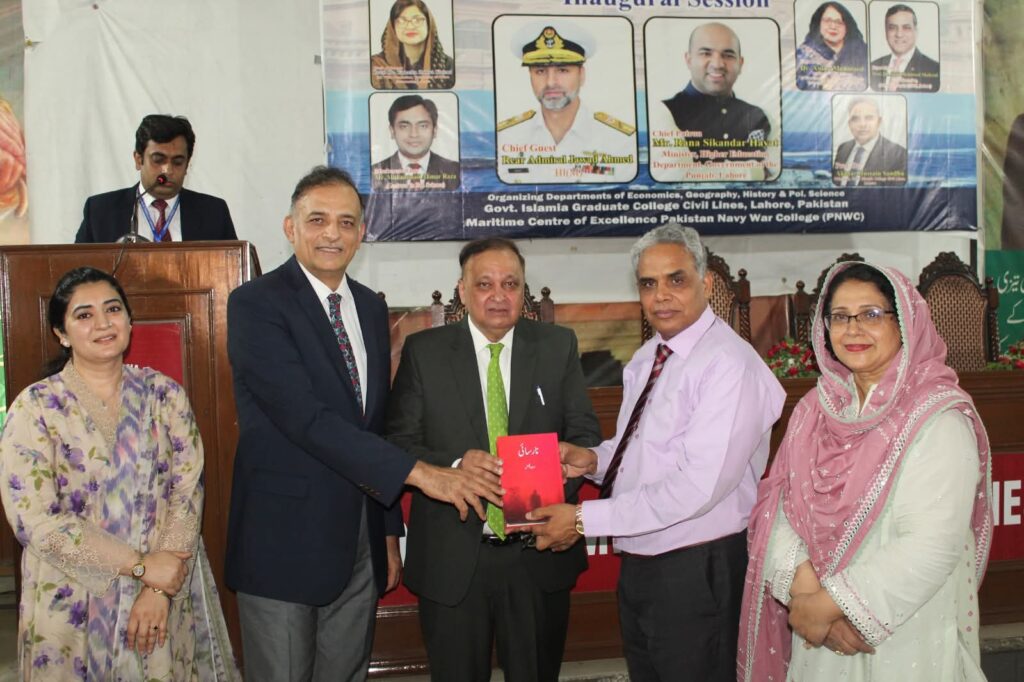Venue: Government Islamia Graduate College, Civil Lines, Lahore (GIGCCL)
In Collaboration With: Maritime Centre of Excellence (MCE), Pakistan Navy War College (PNWC)
1. Introduction
The Faranian National Conference on Maritime Affairs held at GIGCCL marks a significant milestone in promoting maritime awareness in Pakistan. With timely relevance amidst rising geopolitical and environmental uncertainties, this conference has successfully initiated a dialogue between academic institutions, defense forces, and policymakers.
Special recognition is due to Prof. Dr. Akhtar Hussain Sandhu, Principal of GIGCCL, whose visionary leadership enabled the convergence of scholars, students, naval officials, and dignitaries. His initiative sets a strong precedent for academic engagement in national development discourses.
2. Thematic Highlights and Analytical Insights
2.1 Geopolitical Significance of the Indian Ocean Region (IOR)
The IOR remains a theatre of strategic competition involving India, China, and the US. The convergence of traditional and non-traditional maritime threats—including piracy, cyber threats, and climate-related disruptions—demands proactive maritime strategies from Pakistan.
Key Insight: Pakistan must develop a comprehensive maritime security doctrine that is integrated, agile, and diplomacy-backed.
2.2 Blue Economy: A Strategic Lever for Growth
The global blue economy is valued from $1.5 to $3 trillion annually. Pakistan, despite having over 1,000 km of coastline and a vast EEZ, contributes marginally to this sector.
Key Sectors for Development:
- Sustainable fisheries
- Coastal tourism and ecotourism
- Maritime logistics
- Renewable ocean energy
- Shipbuilding and repair
Action Recommendation: Establish Maritime SEZs under CPEC Phase II.
2.3 Academic-Military Collaboration
This event exemplifies the need for sustained academic-defense partnerships. Institutions like PNWC and MCE are well-positioned to enrich national discourse on maritime affairs and to mentor future thought leaders.
2.4 Maritime Security in Hybrid Warfare
Speakers highlighted the emerging complexity of maritime threats. Hybrid tactics—including lawfare, cyber warfare, and grey zone maneuvers—necessitate a shift from reactive to preventive strategic frameworks.
Recommendation: Formulate a National Maritime Security Strategy encompassing cyber, legal, and intelligence dimensions.
2.5 Climate Change and Coastal Resilience
With rising sea levels and environmental degradation, Pakistan’s coastal infrastructure and ecosystems (e.g., mangrove forests) face unprecedented risk.
Key Interventions:
- Mangrove reforestation
- Port emissions reduction
- Marine protected areas
3. SWOT Analysis
Strengths:
- Strategic geography and EEZ
- Presence of multiple ports (Karachi, Port Qasim, Gwadar)
- Naval institutional capacity (PNWC, PMSA)
Weaknesses:
- Fragmented policy and outdated frameworks
- Inadequate maritime infrastructure and R&D
- Limited maritime education and awareness
Opportunities:
- Economic diversification via blue economy
- Maritime tourism, shipping, and logistics
- Regional connectivity through CPEC
Threats:
- Climate vulnerability
- Regional military posturing (India’s naval expansion)
- Illegal fishing, smuggling, and piracy
4. PEST Analysis
Political:
- Outdated maritime policy (2002); needs reform and integration with Vision 2047
- Sino-Indian-US naval posturing complicates regional diplomacy
Economic:
- Untapped blue economy sectors
- Rising freight costs (>$7 billion/year)
- Opportunity for PPPs in port management and shipping
Social:
- Low public and institutional maritime literacy
- Marginalized coastal communities
Technological:
- Lack of port automation and satellite surveillance
- Need for ocean research vessels and marine GIS systems
5. Practical and Doable Recommendations
5.1 Governance & Policy
- Establish a National Maritime Policy Implementation Cell (NMPIC)
- Revise National Maritime Policy with SDG 14 and climate resilience embedded
5.2 Human Capital & Awareness
- Maritime education programs in coastal universities
- Launch Maritime Literacy Campaigns jointly by PNWC, GIGCCL, and MCE
5.3 Infrastructure Development
- Digitize port operations (based on Singapore and Rotterdam models)
- Develop SEZs for fisheries, logistics, and tourism under CPEC
5.4 Strategic Communication
- Establish a National Maritime Think Tank
- Promote documentary and media-based maritime awareness
5.5 Environmental Sustainability
- Launch “Green Maritime Pakistan” campaign
- Enforce mangrove preservation and marine ecosystem monitoring
6. Vision 2047: Pakistan as a Maritime Power
To realize the $100 billion blue economy target by 2047, Pakistan must position itself as the Maritime Gateway of Central and South Asia. Through comprehensive maritime planning, inclusive growth, and regional engagement, this vision can become a strategic reality.
7. Conclusion
Events like the Faranian National Conference are not just academic exercises—they are foundational steps in creating a national maritime ethos. By institutionalizing such initiatives and aligning them with strategic policy goals, Pakistan can safeguard its maritime future and capitalize on its ocean-based assets.
Citations & References
- Brewster, D. (2021). India and China at Sea: Competition for Naval Dominance in the Indian Ocean. Oxford University Press.
- Hussain, S. (2020). “Civil-Military Fusion in Maritime Affairs,” Pakistan Journal of International Affairs.
- UNCTAD. (2021). The Sustainable Blue Economy. https://unctad.org/publication/sustainable-blue-economy
- Planning Commission of Pakistan. (2022). Blue Economy Roadmap. https://pc.gov.pk/uploads/report/Blue_Economy.pdf
- IUCN Pakistan. (2023). Mangrove Conservation in Pakistan. https://www.iucn.org/news/mangroves
- The World Bank. (2020). Blue Economy Development Framework: Pakistan Case Study. https://documents.worldbank.org/en/publication/blue-economy
- Ministry of Maritime Affairs (MoMA), Pakistan. (2023). Annual Report. https://moma.gov.pk/
- Pakistan Navy War College (2022). Maritime Doctrine of Pakistan. PNWC Press.
- Maritime Centre of Excellence (2024). Policy Papers and Strategic Briefs. PNWC Publications.
- UNDP Pakistan. (2021). Coastal Resilience Project Brief. https://www.pk.undp.org/
- Rotterdam Port Authority. (2023). Smart Port Strategies. https://www.portofrotterdam.com/en
